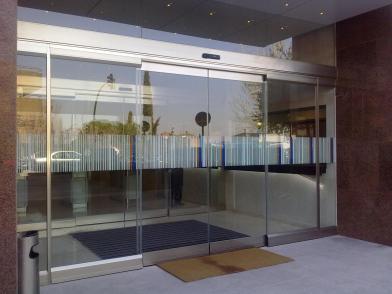

How to save energy with an automatic door
Automatic doors generate savings and reduce harmful emissions in companies, businesses and homes, but their efficiency also depends on how they are used. Using the garage door for people to go in and out, instead of vehicles, increases energy expenditure by over 50%. See all of the tips on optimising their operation.
Office buildings, businesses and companies are usually very compartmented spaces, with different sized areas and different uses, and they can also be changed around during their useful life. It is quite normal for them to be distributed over several floors and some areas have different operating hours, in some cases even operating only occasionally.
As this is an area where many people spend a large amount of time, comfort and air quality are essential, points out Juan Ramírez, President of FIMPA, the National Federation of Door and Automated Device Manufacturers, Installers and Maintenance. This expert also adds that pedestrian automatic doors reduce energy expenditure, because they help to prevent temperature drops. “Proper cooling in times of extreme temperatures contributes to reducing energy expenditure caused by air conditioning units”.
Financial savings
Based on energy savings, the benefits of automatic doors include reduced financial expenditure and reduced harmful emissions to the environment. This will also lead to financial savings, in addition to reducing CO2 and pollution. “We can easily increase energy efficiency by opening the door only when necessary, and the less the doors are used, the lower is the energy expenditure. For example, using the garage door for people to go in and out, instead of vehicles, increases energy expenditure by over 50%”.
According to Ramírez, the automated device must be installed with the proper power. “To this end, when we choose it, we should bear in mind a series of factors, because if we choose a model that has more or less power than is required, the door will use energy by defect or by excess, resulting in a higher expenditure”.
Another suggestion from the President of FIMPA is to increase the waiting time for the door to close. “We should adapt it to the times in the day when people or vehicle traffic is higher. We should take into account the number of users to properly program the waiting time for the door to close”.
Impact on consumption
Industrial and pedestrian doors have a much higher impact on a building’s energy consumption than is usually acknowledged, according to Miguel Pérez, Industrial Engineer and expert on automated accesses and energy efficiency. Pérez is the General Director of Mequonic and he collaborates with AEPA (Business Association for Manual and Automatic Doors) and with the European Door & Shutter Federation (EDSF), as well as with major industry companies on various projects and research.
As this expert points out, most energy losses through doors happen when they remain open longer than they should. A matter that initially seems obvious, but that is extremely important, because the savings achieved thanks to insulation and airtightness are not worth much if the door ends up not closing.
Taking this matter into account, Pérez says that “along with a good thermal insulation, a door with an efficient automation that optimises opening cycles and times essentially contributes to a building’s overall energy efficiency”. He explained that “the industry has promoted several initiatives, both nationally and internationally, to show and raise awareness of automatic doors in building sustainability, such as EDSF’s new European energy labelling system and its associated research program, as well as informative conferences and documents”.





